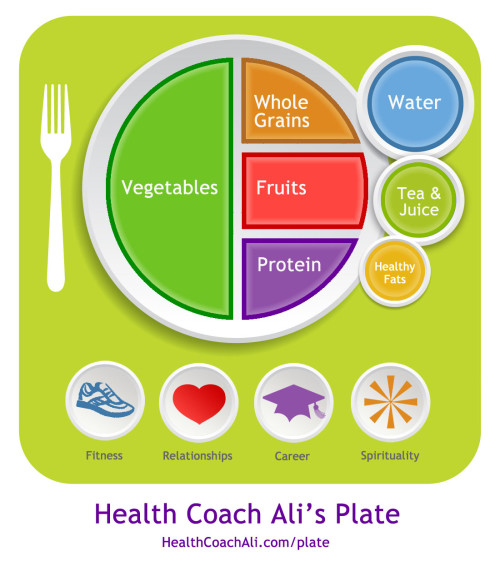This post is a sneak peek at Step 2 of my “7 Steps to Better Health” (what I did to be cured of 4 different ailments). I’m sharing this particular step with you because it was a great help for simplifying healthy portions goals.

When I first started studying portion goals, there was a great deal of conflicting information out there. And most of the plans included counting the grams of each food group I consume throughout the day. Who wants to do that much math? That’s why I love this plate diagram. It gives me a great visual for eating a healthy balance of the 4 major food groups.
What I really found interesting in my studies is how the 4 food groups are classified. Each food group should be determined not only by their macro-nutrients, but also by their micro-nutrients:
1. Macro-nutrients: The large volume of nutrients contained in, or that make up a particular kind of food. These nutrients supply the body with calories needed for energy and to help the body function. The 4 basic food groups: water, carbohydrates, protein and fats are classified according to their macro-nutrients. Macro-nutrients are measured in grams.
2. Micro-nutrients: The smaller nutrients in food which are just as crucial as the macro-nutrients and are needed for development, growth and maintaining a healthy immune system. They are usually counted in milligrams and include vitamins, minerals, and phyto(plant)nutrients which act as antioxidants and antiinflammatories.
Making sure I get enough grams of macro-nutrients is not an adequate measure of what I should eat. I must also aim for getting enough milligrams of micro-nutrients. Counting all of that could be quite daunting! But the plate in this post is a good first step toward making sure I get enough of each.
For now, let’s begin with the thinking process I use to measure what I should eat throughout the day. Here’s what I do: when I am making food choices for a meal I picture the plate diagram in my mind and aim to include each food group in the portions shown (I’m a visual learner. Can you tell?).
But I take it a step further. I also make sure that there are a variety of colors in the fruit and vegetable choices on my plate. The color of fruit and vegetables is a good indication of the micro-nutrients contained in foods like vegetables and fruit. Following this visual assists me in making sure that I am consuming both the macro-nutrients and the micro-nutrients my body needs.
If I miss a certain food group, or food color, during a particular meal, I make up for it in a snack or during the next meal. And when I think back over my intake for the entire day, if I didn’t get enough of a certain food group (such as vegetables) I eat a carrot, sweet pepper, or some celery for an evening snack. This is certainly much easier than counting the grams of the 4 food groups and the milligrams of each vitamin and mineral.
Hint: When I examine the amount of vegetables I’m consuming at a meal, I take into account that my salad would be included in the total vegetable portion.
If you would like more information about what I did to improve my health, along with what I do to stay helathy you can subscribe with the form below. When you do you will receive:
- 7 Steps to Better Health
- A free eBook, “My Food Cure”
- At least one healthy recipe every week
- Information I’ve learned along the way to stay healthy and
- Helpful links to my resources
All of these will help you develop your own plan for living healthy!
To make sure you aren’t missing out on any of this helpful information, and to receive healthy recipes be sure to subscribe to our mailing list:
Source: Health Coach Ali’s Portion Plate
If you decide to adopt these portion goals, please let me know by leaving a comment. And if you have another plan for meeting portion goals, I would love to hear about it!
